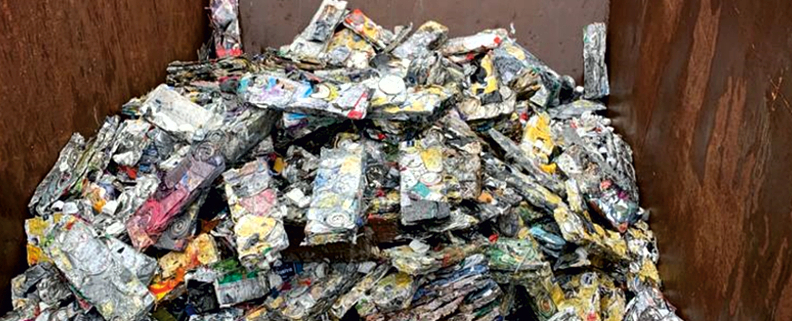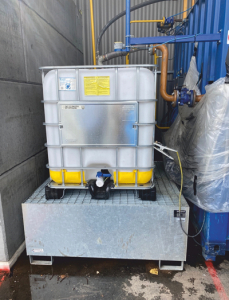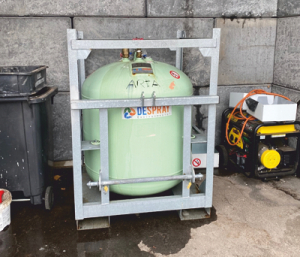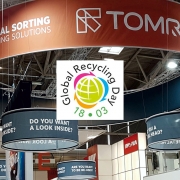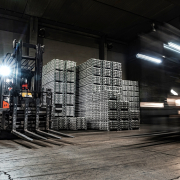The Perfect Trifecta: A Roadmap for more Sustainable Metal Aerosols
Mike MacKay, co-owner and managing director of Despray Environment, which offers a recycling technology for aerosols, warns that the European Commission’s (EC) recently adopted sustainable products initiative is set to rattle the industry.
In what he calls ‘the perfect trifecta’, he outlines below why recycled metal, liquid fuel and propellant fuel are essential pillars of a sustainable aerosol recycling program that could significantly reduce the industry’s carbon footprint and boost its sustainability status.
The EC’s initiative impact
There are serious concerns about the EC’s recently adopted sustainable products initiative. In fact, it can be considered a straight-up gut punch. The initiative is so wide-reaching that it will disrupt the industry at the very least and has the real possibility of doing major damage to certain aspects and products offered by the industry.
The intention of the initiative may not have been to cripple the industry; however, if every detail in it is to be followed it will create far-reaching damages that it may not have intended or even considered. Some of the proposals seem nearly impossible to adhere to. Nonetheless, a significant amount of the targets is attainable over time. The industry can and will unite to address the environmental sustainability of our aerosol products.
Addressing the elephant in the room: true sustainability
Over the last few decades incredible efforts have been made by the aerosol industry to address eco-friendly packaging, plant and supply chain sustainability, logistics and financial resources. The way we think of aerosols’ sustainability may require an additional angle to the tried-and-true methods to date. After all, there is only a finite amount of eco design, reduction of materials, distribution, manufacturing and supply chain carbon footprint that can be tolerated in the packaging design while still keeping products viable and safe. It is also noted that companies are prohibited from making certain types of environmental claims deemed to be misleading. In fact, calling a product sustainable could fall under this statement: Using the words potential sustainability may be more suitable than true sustainability considering aerosol products. So, the issue that needs to be addressed is how to make aerosols more sustainable and still have a profitable and reliable product.
The answer is clearly not inclusive of the upfront efforts implemented to date. The problems concerning the EC’s intentions is that it may warrant additional efforts and perhaps a new way of thinking to address an end of life “true sustainability” claims. The circular economy is achievable for aerosols even as they exist today. Green initiative and environmentalist groups are looking this way whether we accept responsibility or not. They will still be here in the future with growing strength. Now is the time to show industry cohesion and address the elephant in the room: true sustainability. We need to deal with the industries overall environmental and product “end-of-life” impact issues at hand, openly and honestly.
As an ardent advocate of aerosol recycling for 25 years along with its positive environmental impact, I truly believe that as an industry, we must play our role in our planet’s future. Aerosols, as they exist now, can be recycled safely and efficiently while supporting a near 100 percent circular economy. That is worth exploring, and it is worth the effort.
The alarm bells are ringing
The EC’s initiative will lay down a map for eco design requirements, reliability, upgradability, durability and reusability, reparability, resource efficiency as well as maintenance and refurbishment of these products, including presence of substances relating to energy consumption and recycled content. On top of this, better labelling will be required along with introducing an EU-wide packaging deposit return scheme. If that is not enough, measures to limit advertising of products that are environmentally damaging will be introduced. That will include a mandatory disclaimer for products that are particularly harmful for the environment.
The question remains: What can we do with the cards we have to deal with today? That is a tough question to answer. If dealt with independently, all of the line items in the initiative would be taxing enough, but as a combined initiative they may seem impossible or overwhelming. Taking a look from the backside of the business may carry a refreshing outlook that cannot possibly cover all of the topics at hand, but could directly address the sustainability and potential circular economy for the majority of our current aerosol products.
The suggested refill and reuse targets are not only unrealistic, but they may be counterproductive. Reuse and refill are not always the best option from a climate and environmental perspective. The logistical complexities of sorting, return transportation, etc., will be extremely difficult and most likely impossible.
Setting an example: The UK Aerosol Recycling Initiative
Current sustainability and recycling efforts to increase recycling rates of metal cans are already being driven by Alupro (alupro.org.uk), along with Ball Corporation (ball.com), through The UK Aerosol Recycling Initiative (alupro.org.uk/industry/programmes/the-uk-aerosol-recycling-initiative/). The initiative is not only cutting-edge but could be the road map to a sustainable future for the aerosol industry. What started as an initiative to increase low aerosol recycling rates is growing into a full sustainable aerosol recycling platform that can be rolled out across the globe. Making sustainable aerosol products the norm is vital to the future of the aerosol industry.
What exactly would a sustainable aerosol recycling programme look like that could significantly reduce the industries carbon footprint and boost sustainability? The answer is three-fold:
1. Metal Containers
As per the Alupro/Ball initiative, the most obvious target for a more sustainable future will be to increase the recycling rates of metal aerosol cans. The recycled metal containers offer a significantly lower footprint than creating cans from raw materials. Targeting these cans while striving to get close to the recycling rates of soda and soup cans will have a major impact on the aerosol sustainability factor. The barrier to success will be the ability to capture these metals and simultaneously handle flammable propellants and an endless mixture of liquid contents proving to be almost impossible to sort.
- Some aerosol contents are non-toxic, non-hazardous, and environmentally friendly but may be propelled by flammable propellants. Some contents are flammable and considered hazardous and could be filled with flammable propellants or non-flammable propellant systems such as Bag-on-Valve (BOV), pumps, CO2, etc. There seems to be a never-ending combination of possible mixtures of non-Haz Vs, Haz Vs, BOV Vs, pumps, etc.
- The hard facts are that to call aerosols sustainable, all three components – metal, liquid contents and propellants – need to be targeted. Leaving one of the three components out of our targeted recycling loop leaves out the opportunity to be truly sustainable.
2. Liquid contents
The main problem with recycling all these seemingly endless combinations of liquids is that they’re impossible to sort by propellant type or contents composition. Due to sorting impossibility, all aerosols, along with their propellant and liquid contents, need to be treated as hazardous waste or, at the very minimum, as flammable. These cans are almost never empty and could still remain over ten percent or even 15 percent full on average in the post-consumer stream. In conclusion, if all products were recycled together and treated as hazardous waste, the efforts would include minor sorting and limited handling, resulting in a sustainable product.
The good news is that if the liquid contents are mixed together with endless combinations of recipes, they can be 100 percent used for waste-to-energy as a low-grade fuel. That seems easy enough if they are processed in a non-explosive atmosphere. Now we can access the metal can for full recycling, right? Not so fast … it is not that simple. We still have propellants to deal with.
3. Propellants
Now that we have dealt with the recycling issues of the metal cans and the liquid contents, the only thing left for a recycling trifecta is capturing the propellants to reuse as high-grade fuel in waste-to-energy applications. Aerosols have many types of propellant methods including fossil fuels, BOV, pump sprays, CO2 propellants and environmentally friendly propellants. At the recycling centers these all get mixed in with flammable propellants, which again proves that it is impossible to sort aerosols by propellant type.
Since many propellants are flammable and even very explosive, safety measures force all propellants to be treated as flammable or explosive. Sorting by propellant type would be impossible other than special vertical skew markets that can be identified easily. Again, the obvious answer for proper recycling of the propellants in the current state of affairs is to treat all cans as if they have flammable propellants. Once we do that, we can capture the propellants and compress it back to liquid form for easy transport and use for waste-to-energy solutions.
The perfect trifecta: metal recycled + liquid fuel recycled + propellant fuel recycled.
Once the three main components of an aerosol product are captured safely as well as prepared and ready for 100 percent recycling or waste-to-energy applications, we can use the word sustainability with pride and conviction.
We may not have all the tools or political means to change or redirect all the new policies thrown at the aerosol industry right now, but we can deal with the cards we are dealt with to achieve a more sustainable product. The technology already exists for a truly sustainable aerosol market. We need to embrace it sooner than later.
(Published in GLOBAL RECYCLING Magazine 1/2023, Page 31, Photo: Despray)

